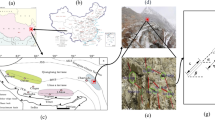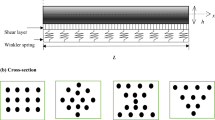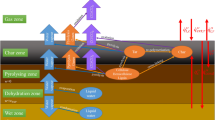Abstract
The load-carrying capacity of notched timber beams can be predicted using linear elastic fracture mechanics (LEFM). Material properties such as fracture toughness and energy are needed for the analysis. The micro and macroscopic complexity of wood and its anisotropic nature give different fracture properties in the longitudinal, radial and tangential grain directions. This complexity and the infrequent use of LEFM mean there is little data available. While wood is highly anisotropic, fracture analysis can use a subset of the possible material properties because wood normally cracks parallel to its grain due to its low tensile strength perpendicular to grain. This allows a significant reduction in the number of tests required to measure fracture properties, with considerable saving of resources. This paper presents the results of an experimental study investigating the fracture energy and fracture toughness of Radiata Pine laminated veneer lumber in mode I (opening). A more efficient test apparatus is proposed and shown to produce identical results to the test apparatus used by others. Results are presented for the fracture toughness properties in the grain direction, and include fifth percentiles and coefficients of variation. The influence that the specimen size has on the fracture toughness is also presented. Numerical analyses using the ABAQUS software package show good agreement with the experimental test results. The experimental results are within the range of experimental values reported in the literature for solid wood.




















Similar content being viewed by others

References
Ardalany M, Deam B, Fragiacomo M (2010) Numerical investigation of the load carrying capacity of laminated veneer lumber joists with holes. Paper presented at the World Conference WCTE2010, Trentino
ASTM (1990) Standard test method of test for plane strain fracture toughness of metallic materials. ASTM E399-83. ASTM International, West Conshohocken
ASTM D2915 (2003) Standard practice for evaluating allowable properties for grades of structural lumber. ASTM International, West Conshohocken. doi:10.1520/D2915-03
Ballerini M, Bezzi R (2001) Numerical LEFM analyses for the evaluation of failure loads of beams loaded perpendicular to grain by single dowel connections. Paper presented at the CIB-W18 conference, Venice
Ballerini M, Bezzi R (2007) Numerical LEFM analyses for the prediction of the splitting strength of beams loaded perpendicular-to-grain by dowel-type connections. J Mater Struc 40(1):139–149. doi:10.1617/s11527-006-9156-2
Buchanan A (2007) Timber design guide, vol 3. 3rd edn. Timber Industry Inc, New Zealand
Chen LS, Kuang JH (1993) A displacement extrapolation method for two dimensional mixed mode crack problems. J Eng Fract Mech 46(5):735–741
Frühmann K, Tschegg EK, Dai C, Stanzl-Tschegg SE (2002) Fracture behaviour of laminated veneer lumber under Mode I and III loading. Wood Sci Technol 36(4):319–334
Green DW (2001) Wood: strength and stiffness. Encyclopaedia of Materials: Science and Technology, Elsevier Science Ltd., Amsterdam
Gustafsson P (1993) fracture mechanics models for strength analysis of timber beams with a hole or a notch: a report of RILEM TC-133: mean stress approach and initial crack approach (paper in report). Vol Report TVSM-7134 Lund University, Sweden
Habbitt, Karlsson, Sorensen (2007a) ABAQUS, Theory Manual, Version 6.10. ABAQUS Inc, Pawtucket
Habbitt, Karlsson, Sorensen (2007b) ABAQUS, User Manual, Version 6.10. ABAQUS Inc
Henshell RD, Shaw KG (1975) Crack tip finite elements are unnecessary. Int J Numer Method Eng 9(3):495–507
Jensen J, Nakatani M, Quenneville P, Walford B (2010) A simple unified model for withdrawal of lag screws and glued-in rods. Eur J Wood Wood Prod 69(4):1–8. doi:10.1007/s00107-010-0478-y
Jernkvist LO (2001) Fracture of wood under mixed mode loading I. Derivation of fracture criteria. J Eng Fract Mech 68(5):549–563
Larsen HJ, Gustafsson J (1990) Determination of fracture energy of wood for tension perpendicular to grain. Paper presented at the CIB-W18 on Timber Structures, Lisbon
Le-Ngoc L, McCallion H (1997) On the fracture toughness of orthotropic materials. J Eng Fract Mech 58(4):355–362
Pattonmallory M, Cramer SM (1987) Fracture-mechanics: a tool for predicting wood component strength. Forest Prod J 37(7–8):39–47
Porteous J, Kermani A (2007) Structural timber design to Eurocode 5. Blackwell Pub., Oxford
Rug W, Badstube M, Schone W (1990) Determination of fracture energy of wood for tension perpendicular to grain. Paper presented at the CIB-W18 on Timber Structures, Lisbon
Schoenmakers D (2010) Fracture and failure mechanisms in timber loaded perpendicular to grain by mechanical connections. University of Eindhoven, Nether lands
Serrano E, Gustafsson P (2007) Fracture mechanics in timber engineering: strength analyses of components and joints. Mater Struct 40(1):87–96
Smith I, Landis E, Gong M (2003) Fracture and fatigue in wood. Wiley, Chichester
Stanzl-Tschegg SE, Tan D-M, Tschegg EK (1995) New splitting method for wood fracture characterization. Wood Sci Technol 29(1):31–50. doi:10.1007/bf00196930
Suo Z, Bao G, Fan B (1992) Delamination R-curve phenomena due to damage. J Mech Phys Solids 40(1):1–16. doi:10.1016/0022-5096(92)90198-b
Vasic S, Smith I (2002) Bridging crack model for fracture of wood. Eng Fract Mech 69:745–760
Vasic S, Smith I, Landis E (2002) Fracture zone characterization: micro-mechanical study. Wood Fiber Sci 34(1):42–56
Wu EM (1967) Application of fracture mechanics to anisotropic plates. J Appl Mech 34(4):967–974
Acknowledgments
The Authors would like to thank Warwick Banks from Carter Holt Harvey and Andrew Van Houtte from Nelson Pine for providing materials for the experimental program. The useful comments provided by Prof. Johan Per Gustaffson from Lund University, Sweden, Dr. Marco Ballerini from the University of Trento, Italy, and two anonymous reviewers are gratefully acknowledged. The personal scholarship from the University of Canterbury, the project support provided by Prof. Andy Buchanan, and the technical support of laboratory technicians from the University of Canterbury, especially Mr. Alan Poynter, are all highly appreciated.
Author information
Authors and Affiliations
Corresponding author
Rights and permissions
About this article
Cite this article
Ardalany, M., Deam, B. & Fragiacomo, M. Experimental results of fracture energy and fracture toughness of Radiata Pine laminated veneer lumber (LVL) in mode I (opening). Mater Struct 45, 1189–1205 (2012). https://doi.org/10.1617/s11527-012-9826-1
Received:
Accepted:
Published:
Issue Date:
DOI: https://doi.org/10.1617/s11527-012-9826-1



